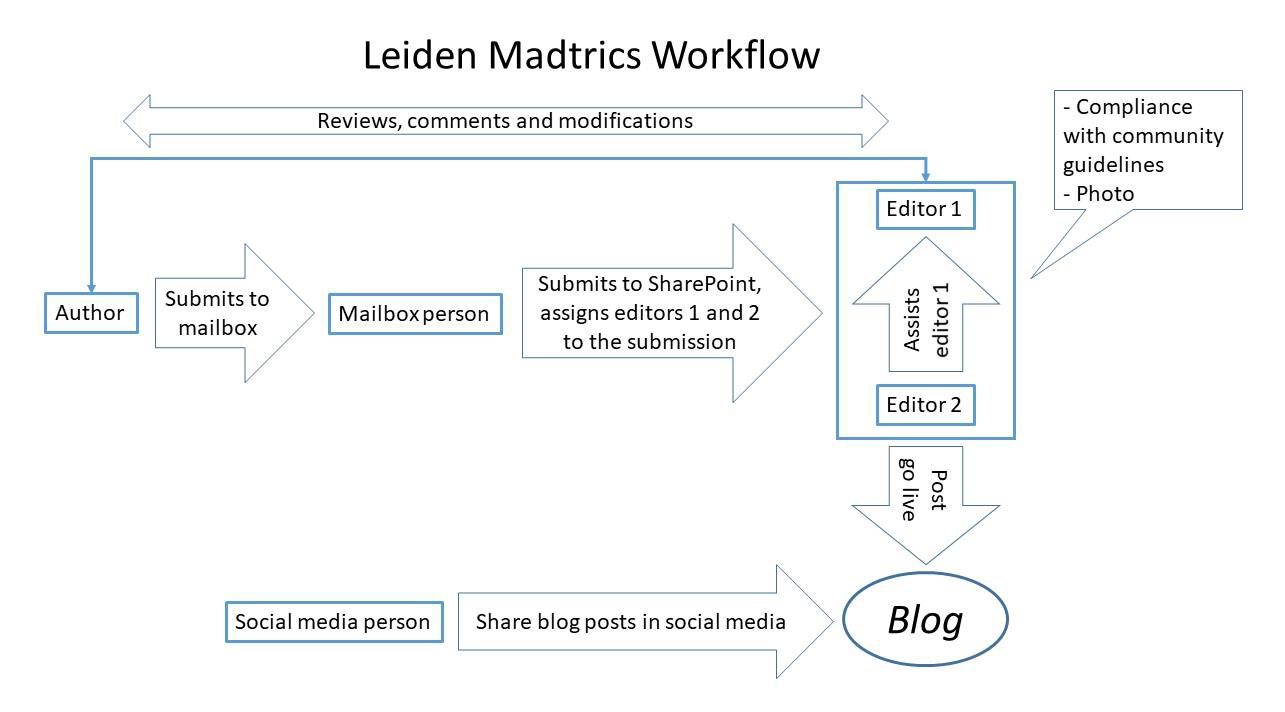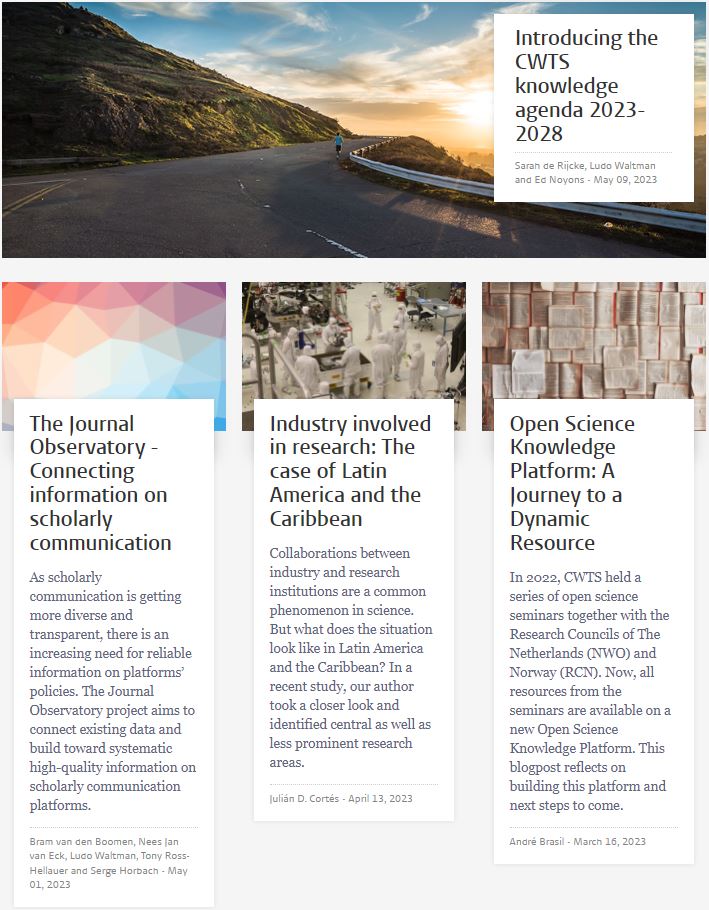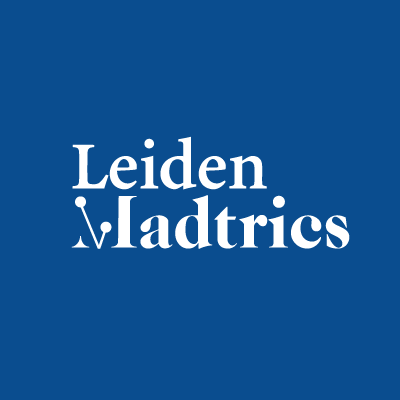Leiden Madtrics is the science blog of CWTS, the Centre for Science and Technology Studies at Leiden University in the Netherlands. CWTS is an interdisciplinary research institute that studies the research system and its connections to society, and offers support for research assessment and science policy.
What was the need for this publication project?
In 2018, CWTS ran an internal project to reflect on its impact and outreach. This project entailed a series of workshops to explore different skills and approaches to impact. One of the last workshops that were part of this project was on the topic of blogging. Jeremy Burman, who held the workshop, made a very convincing case for operating a science blog. Back then, CWTS was already running a blog on its website. This old version did not, however, represent the kind of lively, accessible blog that Burman made us enthusiastic about. On top of that, posts were published rather infrequently and did not come with a transparent review process either. It was clear – this required a complete restart.
At the end of October 2019, we launched Leiden Madtrics, a blog for “metrics and matter that matters”. This new version had to fulfil numerous expectations: it should be a platform to show the different aspects of work at a scientific institute like ours, such as research, project coordination, social life, consultancy, or advocacy. But we also wanted the blog to be equally appealing to academic and non-academic audiences and to be a means to connect with our community at large. Since its relaunch, the renewed blog has continuously operated with this mission in mind.
How has it changed throughout time?
Over the years, there have been two major forces affecting the blog: the editors’ way of work, and the contributions by our authors. Originally, we had started with a rather sophisticated editorial process that defined in very detailed steps how a new submission should be handled. Figure 1 gives an impression of that.

This workflow places as much responsibility on the side of the authors as possible, since the editing team defines its role as facilitator rather than reviewer. This means that authors should make sure that their submission is factually correct, e.g., by seeking a review themselves. Also, as editors we don’t aim to make changes to a blog post but will only make suggestions where necessary. A second important element in our workflow based on our guidelines is a rotating division of tasks: During the editing process – from receiving to finally publishing and distributing a new blog post – two team members are involved, but the first editor will usually have the major part. This role alternates between team members so that the overall commitment is limited, and everyone gets a chance to edit.
Over time, our team has seen some fluctuation from seven members at the start, new members joining over time, and currently four editors active, who have also been among the founding members. With this continuity and the changing of tasks, we were able to build up quite some experience and routine, which has definitely contributed to the sustainability of the blog. It has also provided room for more challenging edits, e.g., the use of dynamic visualizations, the selection of (header) pictures (that are not always provided by the authors), or the communication on channels like Twitter and Mastodon.
The content and direction of the blog has always been dependent on the submissions that the editing team has received. In that sense, the range of blog posts published reflects our authors’ interests, the availability of topics that fit into a blog post, or new developments for which authors chose the blog as communication platform. We have seen this especially during the Covid-19 pandemic: That period has been one of the most prolific for the blog, with quite a number of submissions on how we adapted to the lockdowns, but also the new research that was done on changes and developments in the publication world during the pandemic. Another changing factor has been that we started to actively invite authors from outside of CWTS at some point. Usually, this included guest speakers from seminars or visitors who had spent some time at CWTS.
What is the intellectual agenda the publication wants to pursue?
The central goals of the Leiden Madtrics blog are to be a platform for both the academic and non-academic work done at CWTS, and to be a means to connect with the community. In practice, this means that we strive for a balance of posts spanning the different disciplinary and methodological backgrounds at our institute, different career stages, different types of work and work outcomes and developments (e.g., organisational changes, new initiatives, new platforms or projects…).
Next to that, we also have another, maybe less obvious goal: to demonstrate that academics can write about their research in a ‘light’ way – that you don’t always have to write ‘serious’ texts when it comes to your research. Try out new formats, dare to just jot down your ideas: that is a message we hope to confer with the blog (and to be a platform for).
Has the project and/or its publications been subject to controversy in the sense of difficult decisions made by the editorial team?
Luckily, the Leiden Madtrics blog has not been in the middle of any storm so far. We do, however, see topics that attract more reactions than others. This seems to apply especially to well-known topics around research evaluation (h-index!) and publication practices (think of predatory publishing and editorial practices).
Does the publication have a political stance in the contemporary changing and contested publication sector?
Following its importance at CWTS, Open Science has found its way into many blog posts. Blog posts itself are published under a creative commons license (CC-BY 4.0), which makes it possible to reuse them. Beyond that, we simply wish to give a platform to our authors, which oftentimes includes a more critical stance towards a closed publication system. This also means that we accept blog posts from a broad range of topics and by authors from different disciplines and levels of seniority, also from outside CWTS.
Have there been any difficulties in creating and sustaining this publication project?
The most visionary goals are useless without authors contributing blog posts. Getting people to write has indeed been among our foremost struggles. It might be that authoring blog posts is simply not among the most common or prioritized academic activities, and is still seen as something nice to do ‘on the side’. As a consequence, the set-up of topics in the blog is almost entirely up to the submissions received. Of course, this is fine – a community-driven blog will always be a reflection of what authors submit, and less so of content planned.
More recently, a new challenge has emerged: How do you make sure that contributions are made adequately visible? With so much effort put into a blog post – from authoring to editing it – it is only fair to wish for an audience as broad as possible. However, reaching every reader who could potentially be interested in a piece is not always feasible, especially with very niche topics. The recent developments at Twitter have aggravated this problem, it seems. Some readers have migrated to Mastodon, but with an audience dispersed like that it seems ever harder to create ‘virality’ through which more distant readers might be reached. This remains an ongoing challenge for us. In order to address this, we have started diversifying our outreach and are experimenting with additional platforms.
What readership do you address?
Leiden Madtrics started with a broad audience in mind. This included our colleagues and fellow researchers, and anyone interested in the topics dealt with at CWTS, recent developments in our lines of research and our institute, and the day-to-day experience of working at CWTS. Ideally, this extends towards other groups of readers: students, university administrators, policy makers, and researchers from other, even totally unrelated fields. For all of these groups we envisioned that they might benefit from reading a post here and there, be it by getting inspiration, ideas, insights into or just an introduction to our field. Of course, reality looks a bit different and not all the topics in the blog are of equal interest to everyone. With that in mind, we aim to see the blog more as on offer, where readers can pick a blog post that falls into their interest or domain, with the potential of discovering new topics.
What contributions are you looking for?
New blog posts are always welcome – or just ideas for a blog post, first drafts, suggestions. It can be challenging to adept to the ‘rawer’, more playful nature of blog posts (in contrast to e.g., a journal article). Still, we invite our authors to experiment with blogging as a creative medium that can be used to talk about research in different, even totally new ways: using interactive graphs, interview-like Q&A-style, the form of an essay, or just good old blog style…
When it comes to topics, we require some connection with the areas of research worked in at CWTS. Within that range, almost anything is possible. Think of testing out ideas, sharing ongoing research, reporting on workshops or conferences, parts of research left unfinished… As a rule of thumb: Whenever a topic does not quite fit into a journal article, it might just be perfect for a blog post.
Thinking of a blog post’s audience, authors should expect that they do not only address an academic community. Thanks to being less formal, shorter, and usually timelier, a blog post can attract audiences at the intersection of science and society, (ideally) translating research for non-academic stakeholders. This is not a one-way street: As directly as audiences can be addressed with a blog post, they can provide feedback just as instantaneously. That’s why we say: count on your readers.

